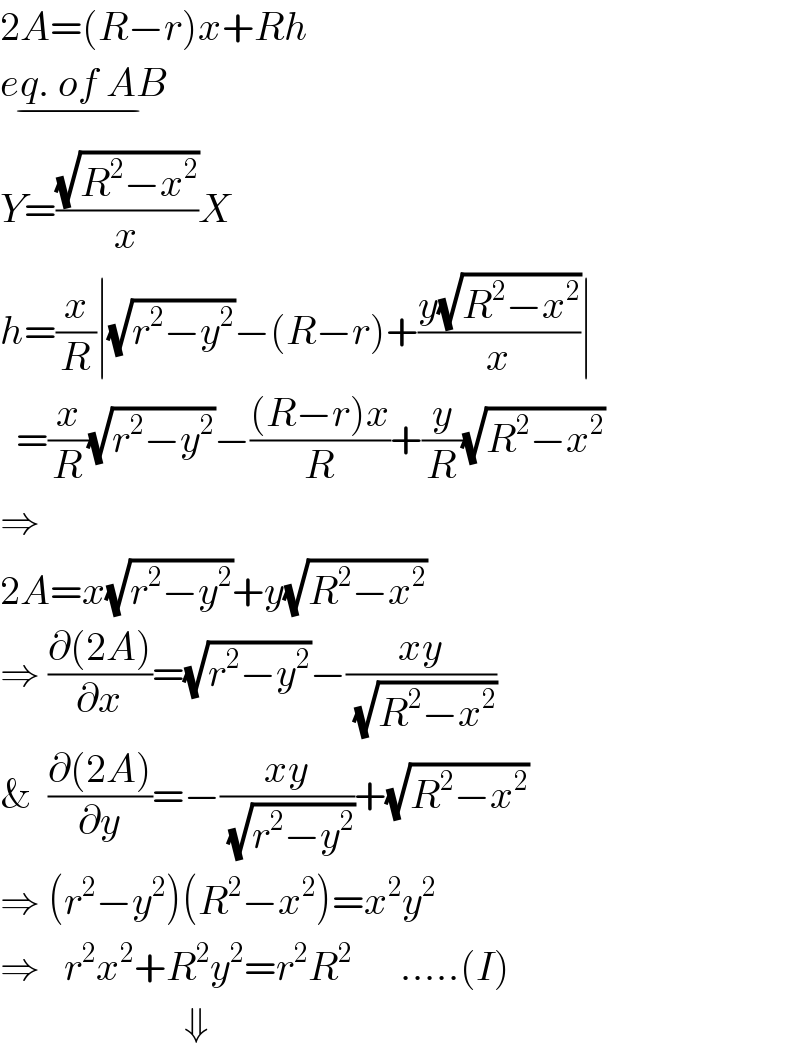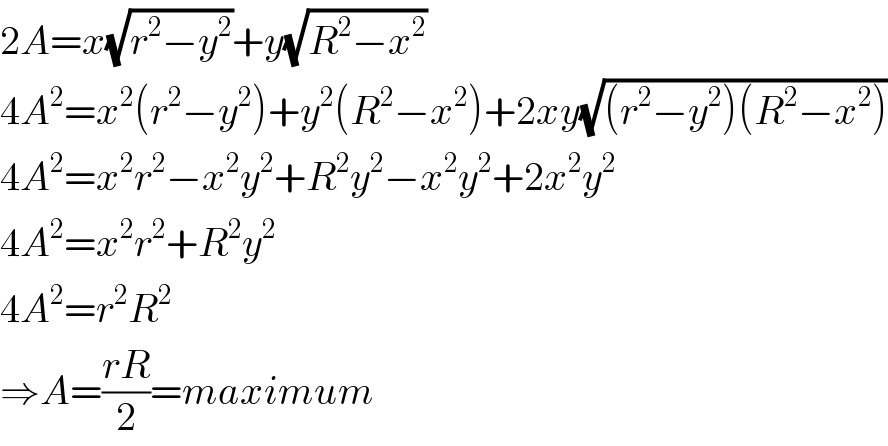
Question Number 62773 by ajfour last updated on 25/Jun/19

Commented by ajfour last updated on 25/Jun/19

$${Find}\:{maximum}\:{area}\:{of}\:{quadrilateral} \\ $$$${in}\:{yellow}\:{in}\:{terms}\:{of}\:{r}\:{and}\:{R}. \\ $$
Answered by ajfour last updated on 25/Jun/19

Commented by ajfour last updated on 25/Jun/19

$$\mathrm{2}{A}=\left({R}−{r}\right){x}+{Rh} \\ $$$$\underset{−} {{eq}.\:{of}\:{AB}} \\ $$$${Y}=\frac{\sqrt{{R}^{\mathrm{2}} −{x}^{\mathrm{2}} }}{{x}}{X} \\ $$$${h}=\frac{{x}}{{R}}\mid\sqrt{{r}^{\mathrm{2}} −{y}^{\mathrm{2}} }−\left({R}−{r}\right)+\frac{{y}\sqrt{{R}^{\mathrm{2}} −{x}^{\mathrm{2}} }}{{x}}\mid \\ $$$$\:\:=\frac{{x}}{{R}}\sqrt{{r}^{\mathrm{2}} −{y}^{\mathrm{2}} }−\frac{\left({R}−{r}\right){x}}{{R}}+\frac{{y}}{{R}}\sqrt{{R}^{\mathrm{2}} −{x}^{\mathrm{2}} } \\ $$$$\Rightarrow \\ $$$$\mathrm{2}{A}={x}\sqrt{{r}^{\mathrm{2}} −{y}^{\mathrm{2}} }+{y}\sqrt{{R}^{\mathrm{2}} −{x}^{\mathrm{2}} } \\ $$$$\Rightarrow\:\frac{\partial\left(\mathrm{2}{A}\right)}{\partial{x}}=\sqrt{{r}^{\mathrm{2}} −{y}^{\mathrm{2}} }−\frac{{xy}}{\sqrt{{R}^{\mathrm{2}} −{x}^{\mathrm{2}} }} \\ $$$$\&\:\:\frac{\partial\left(\mathrm{2}{A}\right)}{\partial{y}}=−\frac{{xy}}{\sqrt{{r}^{\mathrm{2}} −{y}^{\mathrm{2}} }}+\sqrt{{R}^{\mathrm{2}} −{x}^{\mathrm{2}} } \\ $$$$\Rightarrow\:\left({r}^{\mathrm{2}} −{y}^{\mathrm{2}} \right)\left({R}^{\mathrm{2}} −{x}^{\mathrm{2}} \right)={x}^{\mathrm{2}} {y}^{\mathrm{2}} \\ $$$$\Rightarrow\:\:\:{r}^{\mathrm{2}} {x}^{\mathrm{2}} +{R}^{\mathrm{2}} {y}^{\mathrm{2}} ={r}^{\mathrm{2}} {R}^{\mathrm{2}} \:\:\:\:\:\:.....\left({I}\right) \\ $$$$\:\:\:\:\:\:\:\:\:\:\:\:\:\:\:\:\:\:\:\:\:\:\:\Downarrow\: \\ $$
Commented by mr W last updated on 25/Jun/19

$${that}\:{means}\:{when}\:\left({I}\right)\:{is}\:{fulfilled},\:{the} \\ $$$${yellow}\:{area}\:{is}\:{constant}\:{and}\:{maximum},\: \\ $$$${no}\:{matter}\:{which}\:{values}\:{x}\:{and}\:{y}\:{have}. \\ $$
Commented by mr W last updated on 25/Jun/19

$$\mathrm{2}{A}={x}\sqrt{{r}^{\mathrm{2}} −{y}^{\mathrm{2}} }+{y}\sqrt{{R}^{\mathrm{2}} −{x}^{\mathrm{2}} } \\ $$$$\mathrm{4}{A}^{\mathrm{2}} ={x}^{\mathrm{2}} \left({r}^{\mathrm{2}} −{y}^{\mathrm{2}} \right)+{y}^{\mathrm{2}} \left({R}^{\mathrm{2}} −{x}^{\mathrm{2}} \right)+\mathrm{2}{xy}\sqrt{\left({r}^{\mathrm{2}} −{y}^{\mathrm{2}} \right)\left({R}^{\mathrm{2}} −{x}^{\mathrm{2}} \right)} \\ $$$$\mathrm{4}{A}^{\mathrm{2}} ={x}^{\mathrm{2}} {r}^{\mathrm{2}} −{x}^{\mathrm{2}} {y}^{\mathrm{2}} +{R}^{\mathrm{2}} {y}^{\mathrm{2}} −{x}^{\mathrm{2}} {y}^{\mathrm{2}} +\mathrm{2}{x}^{\mathrm{2}} {y}^{\mathrm{2}} \\ $$$$\mathrm{4}{A}^{\mathrm{2}} ={x}^{\mathrm{2}} {r}^{\mathrm{2}} +{R}^{\mathrm{2}} {y}^{\mathrm{2}} \\ $$$$\mathrm{4}{A}^{\mathrm{2}} ={r}^{\mathrm{2}} {R}^{\mathrm{2}} \\ $$$$\Rightarrow{A}=\frac{{rR}}{\mathrm{2}}={maximum} \\ $$
Commented by ajfour last updated on 25/Jun/19

$${Thanks}\:{sir},\left({great}\:{way}\right)\:{nice}\: \\ $$$${concluion}. \\ $$
Commented by mr W last updated on 25/Jun/19

Commented by mr W last updated on 25/Jun/19

Answered by mr W last updated on 25/Jun/19

Commented by mr W last updated on 25/Jun/19
![take point B at any angle θ. such that area of AOB is maximum, tangent AD should be parallel to OB. we get ∠ACO=θ and OB⊥AC. Δ_(ABC) =((AC×(OB+CO×sin θ))/2)=((r[R+(R−r)sin θ])/2) Δ_(AOC) =((r(R−r)sin θ)/2) A=yellow area=Δ_(ABC) −Δ_(AOC) =((r[R+(R−r)sin θ])/2)−((r(R−r)sin θ)/2) =((rR)/2)=constant independent from θ since OB⊥AC, we can directly see: yellow area A=((AC×OB)/2)=((rR)/2)](Q62799.png)
$${take}\:{point}\:{B}\:{at}\:{any}\:{angle}\:\theta. \\ $$$${such}\:{that}\:{area}\:{of}\:{AOB}\:{is}\:{maximum}, \\ $$$${tangent}\:{AD}\:{should}\:{be}\:{parallel}\:{to}\:{OB}. \\ $$$${we}\:{get}\:\angle{ACO}=\theta\:{and}\:{OB}\bot{AC}. \\ $$$$\Delta_{{ABC}} =\frac{{AC}×\left({OB}+{CO}×\mathrm{sin}\:\theta\right)}{\mathrm{2}}=\frac{{r}\left[{R}+\left({R}−{r}\right)\mathrm{sin}\:\theta\right]}{\mathrm{2}} \\ $$$$\Delta_{{AOC}} =\frac{{r}\left({R}−{r}\right)\mathrm{sin}\:\theta}{\mathrm{2}} \\ $$$${A}={yellow}\:{area}=\Delta_{{ABC}} −\Delta_{{AOC}} \\ $$$$=\frac{{r}\left[{R}+\left({R}−{r}\right)\mathrm{sin}\:\theta\right]}{\mathrm{2}}−\frac{{r}\left({R}−{r}\right)\mathrm{sin}\:\theta}{\mathrm{2}} \\ $$$$=\frac{{rR}}{\mathrm{2}}={constant}\:{independent}\:{from}\:\theta \\ $$$$ \\ $$$${since}\:{OB}\bot{AC},\:{we}\:{can}\:{directly}\:{see}: \\ $$$${yellow}\:{area}\:{A}=\frac{{AC}×{OB}}{\mathrm{2}}=\frac{{rR}}{\mathrm{2}} \\ $$
Commented by ajfour last updated on 25/Jun/19

$${Good}\:\mathcal{M}{agic},\:{best}\:{explained}! \\ $$$${Thanks}\:{Sir}. \\ $$
